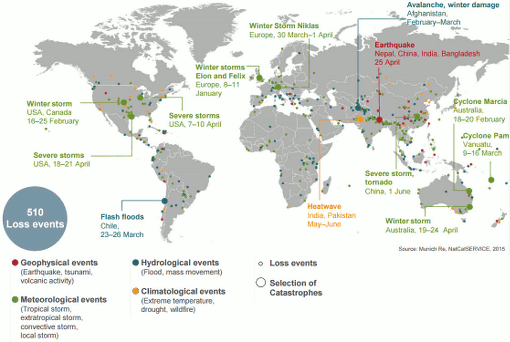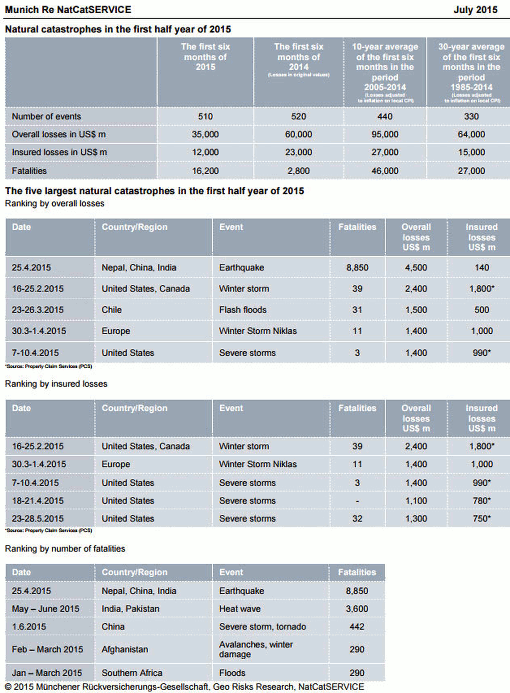Global insurance industry catastrophe losses for the first-half of 2015 are some 56% less than the 10-year average ($27 billion) at $12 billion, and insured losses from the U.S. contributed 67%, or roughly $8 billion of the total, according to reinsurer Munich Re.
Relentless, intense winter storms across Northeastern states of America and parts of Canada, coupled with the devastating Nepal earthquake and heatwave in parts of Asia ensured a global economic loss from natural catastrophes of $35 billion, according to Munich Re’s recent H1 2015 global catastrophe report.
“The natural catastrophes in the first half of the year show us once again that vulnerability to natural catastrophes needs to be reduced, particularly in emerging and developing countries. This is necessary first of all to ensure people are better protected, but also to keep losses as low as possible,” advised Munich Re Board member and Chief Executive Officer (CEO) of its reinsurance operations, Torsten Jeworrek.
Insurance industry losses during Q1 and Q2 fell below the 10-year ($27 billion) and 30-year ($15 billion) averages.
And this was the case for overall economic losses also, with the $35 billion witnessed during H1 2015 falling way below the 10-year ($95 billion) and 30-year ($64 billion) averages.
The costliest event in terms of overall, or economic losses was the magnitude 7.8 earthquake that impacted Nepal in April, killing 8,850 people and incurring overall losses of roughly $4.5 billion.
Important to note, and revealing just how broad the insured-economic loss gap is in poorer, developing regions of the globe, the insured loss for this event amounted to just $140 million, or 3.1% of the overall loss. Munich Re added, “the losses accounted for almost a quarter of Nepal’s annual gross domestic product.”
In contrast to this, Munich Re notes that the costliest natural disaster event for the insurance industry during H1 2015 came from the severe winter weather in the U.S. and Canada, where insured losses equated to 75%, or $1.8 billion of the $2.4 billion economic loss total for the event.
That’s a hugely significant difference in the amount of people who are protected and compensated following a catastrophe event via re/insurance, signalling just how vital it is for the industry to innovate and develop affordable, efficient products to help protect the world’s most vulnerable people from adverse weather events.
Despite global insured losses of $12 billion being almost half that of H1 2014’s $23 billion total, the number of fatalities during the first two quarters of 2015 totalled 16,200, a significant hike from the 2,800 fatalities incurred during the same period last year.
The majority of deaths (8,850) came from the earthquake in Nepal, while the prolonged, intense heatwave across parts of India and Pakistan claimed 3,600 lives, and severe storms in China took the lives of 442 people.
Despite Munich Re reporting that fatalities during the months of 2015 greatly outnumber those of H1 2014, the total is considerably lower than the 10-year (46,000) and 30-year (27,000) averages.
Moving away from the Americas and Asia the report highlights some large losses in Europe from winter storm Niklas, which caused total economic losses of $1.4 billion, of which an estimated $1 billion was insured.
Interestingly, reinsurer Aon Benfield recently published its mid-year Reinsurance Market Outlook report, stating that total insurance industry losses for the quarter equalled $14 billion.
This is roughly $2 billion more than Munich Re’s total and shows just how different firms’ estimated insured and economic loss totals can be when analysing the same catastrophe events.
Munich Re concludes that current El Niño conditions are predicted to intensify in the coming months, which Peter Höppe, Head of Geo Risks Research at Munich Re feels could have impacted the extreme weather trend. More on the developing El Niño and the latest forecast in our recent article here.
He said; “So the trends for 2015, with a large number of severe weather events in the South of the USA, and little hurricane activity in the North Atlantic so far, could therefore be expected. Likewise, the severity of the heatwave in India and Pakistan was probably partially influenced by the El Niño conditions.”
 View all of our Artemis Live video interviews and subscribe to our podcast.
View all of our Artemis Live video interviews and subscribe to our podcast.
All of our Artemis Live insurance-linked securities (ILS), catastrophe bonds and reinsurance video content and video interviews can be accessed online.
Our Artemis Live podcast can be subscribed to using the typical podcast services providers, including Apple, Google, Spotify and more.

Global insured catastrophe loss map - Source: Munich Re

First-half 2015 global natural disaster insurance industry loss statistics - Source: Munich Re































